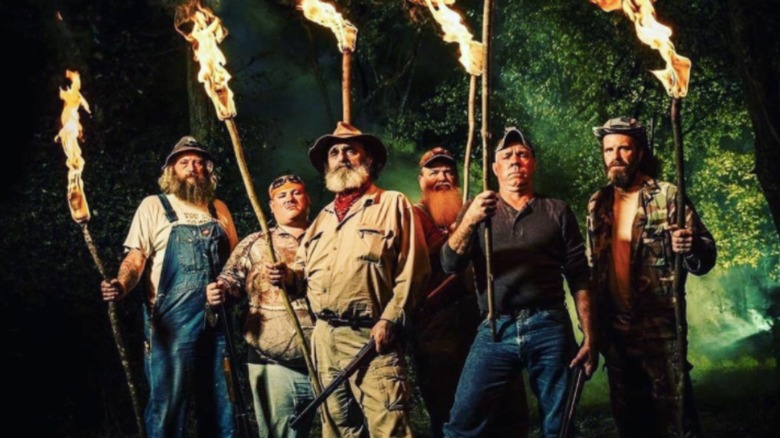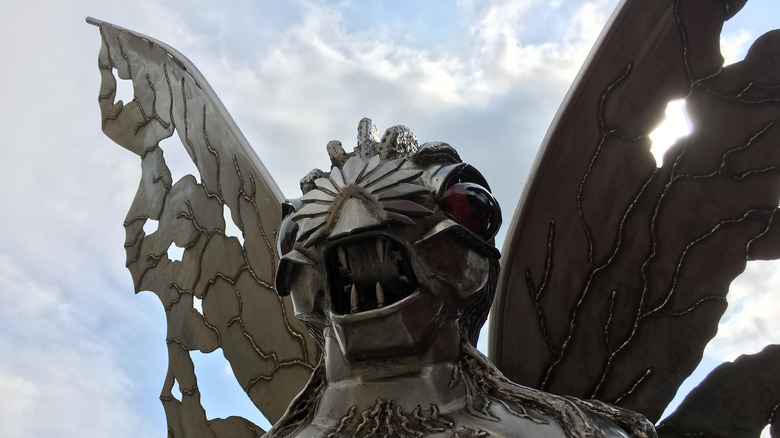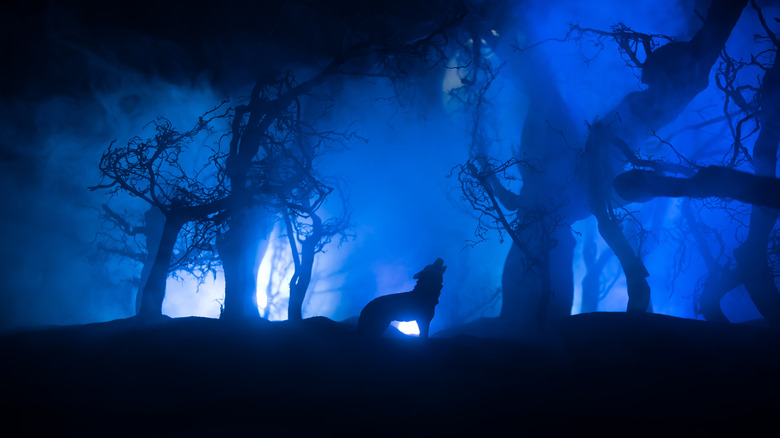The Untold Truth Of Mountain Monsters
Whether you believe in them or not, monsters are out there. At least that's what the guys from Travel Channel's "Mountain Monsters" would have you believe. The wildly popular "reality" TV show has been feeding American viewers their regular monster fix since 2013, when it debuted on Destination America. According to Fox, its pilot episode pulled in the highest ratings numbers in the channel's broadcast history, so it's no surprise that it was picked up by Travel Channel after five successful seasons.
"Mountain Monsters" follows a group of old Appalachian hillbillies with more hair growing off their chins than they ever saw on top of their heads when they had it. Calling themselves the Appalachian Investigators of Mysterious Sightings, or A.I.M.S., they scour their namesake mountain range in search of any and all creatures that normal science can't pin down into its taxonomy of animals that actually exist. We're talking Bigfoot, of course, and werewolves, and other man-beast hybrids that for some reason keep being spotted in a region of the United States that's also known — curiously enough — for its moonshine consumption.
The A.I.M.S. team was originally led by John "Trapper" Tice, a native Virginian who had been hunting and trapping in the Appalachians since he was a kid, according to his obituary posted by the Ingram Funeral Home. Although he is sorely missed, the other guys on the A.I.M.S. team continue his legacy of tracking down the inexplicable things people claim to have seen in the forest.
A crash course in cryptozoology
The guys from "Mountain Monsters" consider themselves cryptozoologists. What is cryptozoology, you ask? It is the study of creatures whose existence has not been confirmed by science. Many scientists in fields related to cryptology, such as biology and conservation, consider it a pseudoscience. As Cambridge professors Bill Adams and Shane McCorristine write for The Conversation, many conservationists consider the hunt for cryptids, i.e., mythical creatures, to be a waste of time when we've got so many other animals whose existences are both confirmed and threatened who need our protection.
Not all, however, can so easily dub cryptozoology as a waste of time. National Geographic spoke with Daniel Loxton and Donald R. Prothero, who applied scientific rigor to the search for Bigfoot and other most likely imaginary creatures in their 2013 book "Abominable Science! Origins of the Yeti, Nessie, and other Famous Cryptids." Although their overall opinion seems to be that the science doesn't back up cryptozoological claims, that doesn't stop them from wishing it wasn't so. When asked which cryptid he would like to be real, Loxton responded, "All of them."
It's obvious and understandable that cryptozoology carries more weight in pop culture than in the scientific community. "Mountain Monsters" is just one of several popular TV shows following monster hunters, and as Fox points out, cryptozoology has even spawned a new risqué literary subgenre. Monster erotica, which features beasts like Bigfoot hunting, kidnapping, and having their way with young women, is growing in popularity among self-publishing authors.
Other cryptozoological creatures you may not know about
We're all well-acquainted with the superstars of cryptozoology: Bigfoot, werewolves, Nessie the Loch Ness monster. But there are actually quite a few cryptids out there (theoretically speaking) that you may not be familiar with. In fact, The Smokies listed several cryptids that have been the targets of the A.I.M.S. team's hunts, many of which are not as famous as Bigfoot, Yahoo, Sasquatch, Yeti, or whatever you call him in your neck of the woods. For example, another mystery beast that is infamous in cryptozoological circles is the Mothman, which is what it sounds like: a man-like creature with large wings and a head like a moth's. At nearly eight feet tall, 600 pounds, and a 10-foot wingspan, it's no wonder so many folks claim to have spotted him soaring overhead. Also in the lab experiment gone wrong department is the lizard man, of which there have been sightings everywhere from West Virginia to South Carolina.
The "Mountain Monster" guys also go for things like devil dogs or hellhounds, which are basically oversized dogs, and Wampus beasts, which are pretty much black panthers where black panthers aren't known to live. Then there's Hogzilla, a nine-foot-long pig somewhere in Ohio that purportedly weighs around 1200 pounds. Laugh all you want, but as Paranormalistics notes, cryptozoologists point to animals like Komodo dragons and okapis — a weird donkey-giraffe-zebra hybrid — as proof that their branch of science is a real science. Both of those animals started out as seemingly harebrained rumors before being accepted by mainstream science.
The Mountain Monsters feud with Finding Bigfoot explained
With cryptozoological shows as popular as they are, you can bet there's going to be some competition out there, not only to grab more monsters, but also to grab more viewers. And in 2015, the tension between the guys from "Mountain Monsters" and the team from Animal Planet's "Finding Bigfoot" exploded into an all-out Twitter war.
Matt Moneymaker of "Finding Bigfoot" was the first to fire a volley in the digital skirmish, when on April 5 he tweeted, "I actually need to explain this to some people: 'Mountain Monsters' is a scripted fictional show. Those guys are all actors. It's all faked." Trapper crawled out of the woods a few weeks later to respond with a sick burn: "I'm not an actor. Sometimes I feel your show should be called Losing Bigfoot. Keep up the good work bud."
That was merely the first battle in what would become a years-long feud between the two shows. In January 2017, when a fan asked "Finding Bigfoot" host Cliff Barackman if he'd ever consider teaming up with the "Mountain Monsters" guys, Barackman replied curtly, "Nope. Fiction." Then some genius in Animal Planet's social media department used the official "Finding Bigfoot" Twitter account to enigmatically call the rival program a "hoax- fake show," whatever that means. (Wouldn't the double negative mean that "Mountain Monsters" is the real show, and "Finding Bigfoot" is the fake show about hoaxes?) Anyway, the feud appears to have gone cold for now, but the tensions still simmer under the surface.
The tragic death of Mountain Monsters' John 'Trapper' Tice
In late 2019, the "Mountain Monsters" crew and fans around the world were saddened by the news of the death of John "Trapper" Tice. He was 72 years old. According to Country Living, he died surrounded by his loved ones after a "brief illness." Travel Channel said in a statement that it was "sad to hear about [his] passing." Trapper's son, also John, lamented his father's death on Facebook, saying, "The person on the tv screen pales in comparison to the actual legend of man, father and grandfather he was. The silence of his absence in our lives is deafening. Love you, Dad."
Trapper really was the heart and soul of "Mountain Monsters," and his death led some to wonder whether or not the show would be coming back for a seventh season. As Discovery announced in a press release in November 2020, the show was to return in January 2021. But first, it had to honor Trapper's memory with a 2-hour tribute episode dedicated to the lost team member. And as fans learned once season seven got started, Trapper is still very much a part of the show.
The A.I.M.S. team continues to follow Trapper's footsteps
Even though he's gone, Trapper's spirit is still alive and well in the latest season of "Mountain Monsters." As the show's producer Colt Straub told the Charleston Gazette-Mail, "Trapper left one final mystery that goes all the way back to how he got started with cryptid creatures in the Tygart Valley in West Virginia." So in the absence of their former leader, the A.I.M.S. team is bringing "Mountain Monsters" full circle, back to where all the kooky cryptozoological madness began for them decades ago. "Trapper had a lifelong fascination with cryptids and the unexplained," said Straub. "He was the most knowledgeable outdoorsman I ever spoke to, let alone spent time with. I think he got obsessed with all things cryptid and assembled this team around him."
Because of that obsession, the team now has a part of Trapper to serve as their guide on their latest hunts. After his death, Trapper's daughter and granddaughter gave the A.I.M.S. team his monster hunting journal, and they're using it to seek out some pretty legendary wolves believed to still inhabit the Tygart Valley, despite reports of them being killed off long ago. "Trapper turned out to be as unpredictable in death as he was in life," said Straub. "Mountain Monsters" airs Sundays on the Travel Channel and is also available for streaming on Discovery+.





